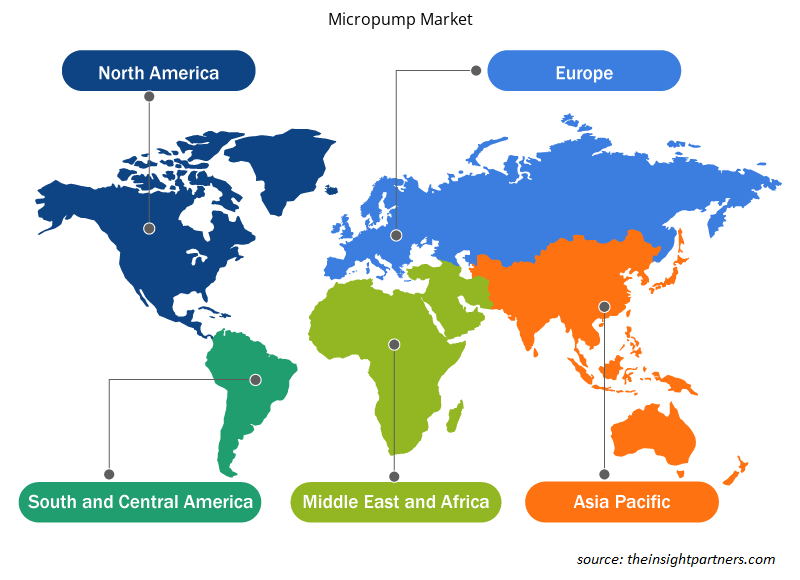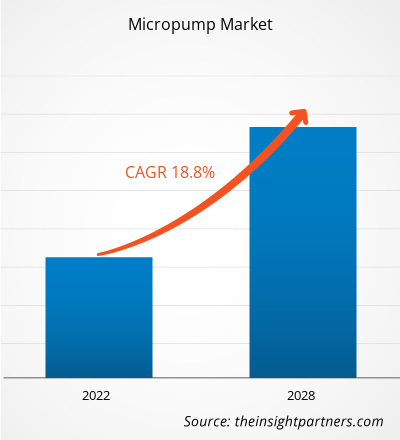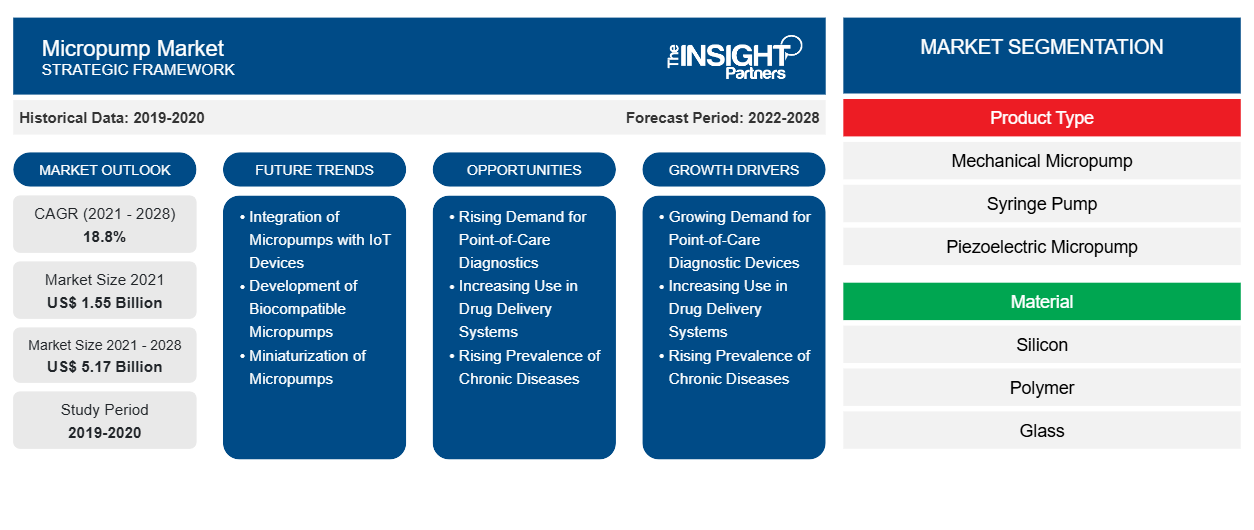Se espera que el mercado de microbombas alcance los 5.172,86 millones de dólares en 2028, frente a un valor estimado de 1.553,01 millones de dólares en 2021. Es probable que el mercado crezca a una CAGR del 18,8 % entre 2021 y 2028.
El alcance del mercado de microbombas incluye el tipo de producto, el material, la aplicación, el usuario final y la región. Según la región, el mercado de microbombas está segmentado en América del Norte, Europa, Asia Pacífico, Oriente Medio y África, y América del Sur y Central. El informe ofrece información y un análisis en profundidad del mercado de microbombas haciendo hincapié en varios parámetros, como las tendencias del mercado, los avances tecnológicos, la dinámica del mercado y el análisis del panorama competitivo de los principales actores del mercado en todo el mundo. También incluye un análisis del impacto de COVID-19 en las regiones.
Personalice este informe según sus necesidades
Obtendrá personalización en cualquier informe, sin cargo, incluidas partes de este informe o análisis a nivel de país, paquete de datos de Excel, así como también grandes ofertas y descuentos para empresas emergentes y universidades.
- Obtenga las principales tendencias clave del mercado de este informe.Esta muestra GRATUITA incluirá análisis de datos, desde tendencias del mercado hasta estimaciones y pronósticos.
Perspectivas del mercado
Demanda creciente de microbombas en la industria de dispositivos médicos
En los últimos años, la liberación controlada de fármacos ha planteado numerosos desafíos, como la liberación de la cantidad adecuada de fármacos en el momento adecuado con la menor invasividad y la mayor demanda de dispositivos avanzados de administración de fármacos. Algunos de los factores que desafían a los dispositivos convencionales de administración de fármacos incluyen tratamientos a largo plazo, ventanas terapéuticas estrechas, programas de dosificación complejos, terapias combinadas y regímenes de dosificación individuales. La aparición de sistemas microelectromecánicos (MEMS) que combinan componentes mecánicos y eléctricos está proporcionando una solución para superar estos inconvenientes. La creciente adopción de dispositivos médicos miniaturizados ha ayudado a remodelar la industria de los dispositivos médicos. Debido a los crecientes costos de la atención médica y el cambio a la atención ambulatoria en el hogar, la demanda de productos más pequeños, livianos y portátiles ha aumentado enormemente. La miniaturización de un dispositivo médico se puede lograr de varias maneras; una de las más importantes es a través de microbombas. Las microbombas se asocian con menores costos de producción, menos fugas, menor consumo de energía y mayor precisión debido al flujo controlado de fluidos y la administración de la dosis del fármaco en el cuerpo. Pueden manejar volúmenes extremadamente pequeños de líquido de manera eficiente. Las microbombas se están desarrollando para una variedad de aplicaciones médicas, incluida la administración transdérmica de insulina, el transporte de sangre a través de corazones artificiales, la inyección de glucosa y medicamentos, el tratamiento hormonal y el manejo del dolor y el cuidado de heridas. Además, los fabricantes están lanzando una amplia gama de microbombas para satisfacer la creciente demanda de la industria de dispositivos médicos. Por ejemplo, en noviembre de 2019, TTP Ventus Ltd lanzó una nueva serie de microbombas HP que proporciona mayores caudales y presiones. Esto ha abierto posibilidades de innovación de productos para aplicaciones que incluyen investigación de microfluidos, diagnósticos médicos, dispositivos terapéuticos y wearables. Además, las microbombas se utilizan para nuevas aplicaciones médicas. Por ejemplo, en septiembre de 2018, Sensile Medical recibió la certificación de la UE para su microbomba portátil diseñada para el tratamiento de la enfermedad de Parkinson. El dispositivo es fácil de usar y tiene características como el llenado automático con medicamento líquido, pantalla a color, unidad de carga y almacenamiento de datos que ayudan a mejorar la gestión de la terapia.
Información basada en el tipo de producto
El mercado de microbombas, por tipo de producto, se segmenta en microbombas mecánicas, bombas de jeringa, microbombas piezoeléctricas, bombas peristálticas y microbombas no mecánicas. El segmento de microbombas mecánicas tuvo la mayor participación del mercado en 2021, sin embargo, se prevé que el segmento de microbombas no mecánicas registre la CAGR más alta del 19,7 % en el mercado durante el período de pronóstico.
Perspectivas basadas en materiales
El mercado de microbombas, según el material, se segmenta en silicio, polímero y vidrio. En 2021, es probable que el segmento de silicio tenga la mayor participación del mercado, sin embargo, se espera que el segmento de polímeros crezca al ritmo más rápido durante los próximos años.
Perspectivas basadas en aplicaciones
El mercado de microbombas por aplicación está segmentado en equipos y dispositivos médicos, laboratorios clínicos y analíticos, productos farmacéuticos, biotecnología y otros. Es probable que el segmento de equipos y dispositivos médicos tenga la mayor participación del mercado en 2021, y se prevé que el mismo segmento registre la CAGR más alta del 19,5 % del mercado durante el período de pronóstico.
Información basada en el usuario final
El mercado de microbombas por usuario final está segmentado en hospitales y centros de diagnóstico, empresas biotecnológicas y farmacéuticas, e institutos académicos y de investigación. Es probable que el segmento de hospitales y centros de diagnóstico tenga la mayor participación del mercado en 2021 y se prevé que registre la CAGR más alta del 19,3 % del mercado durante el período de pronóstico.
Las estrategias inorgánicas, como las asociaciones y las fusiones y adquisiciones, son comúnmente adoptadas por las empresas para satisfacer la demanda cambiante de los clientes y mantener su marca en todo el mundo. Los actores del mercado que operan en el mercado de microbombas también adoptan estrategias orgánicas, como el lanzamiento y la expansión de productos, para ampliar su presencia y su cartera de productos en todo el mundo, así como para satisfacer la creciente demanda.
Perspectivas regionales del mercado de microbombas
Los analistas de Insight Partners explicaron en detalle las tendencias y los factores regionales que influyen en el mercado de microbombas durante el período de pronóstico. Esta sección también analiza los segmentos y la geografía del mercado de microbombas en América del Norte, Europa, Asia Pacífico, Oriente Medio y África, y América del Sur y Central.

- Obtenga los datos regionales específicos para el mercado de microbombas
Alcance del informe de mercado de microbombas
| Atributo del informe | Detalles |
|---|---|
| Tamaño del mercado en 2021 | 1.550 millones de dólares estadounidenses |
| Tamaño del mercado en 2028 | 5.170 millones de dólares estadounidenses |
| CAGR global (2021-2028) | 18,8% |
| Datos históricos | 2019-2020 |
| Período de pronóstico | 2022-2028 |
| Segmentos cubiertos | Por tipo de producto
|
| Regiones y países cubiertos | América del norte
|
| Líderes del mercado y perfiles de empresas clave |
|
Densidad de actores del mercado: comprensión de su impacto en la dinámica empresarial
El mercado de microbombas está creciendo rápidamente, impulsado por la creciente demanda de los usuarios finales debido a factores como la evolución de las preferencias de los consumidores, los avances tecnológicos y una mayor conciencia de los beneficios del producto. A medida que aumenta la demanda, las empresas amplían sus ofertas, innovan para satisfacer las necesidades de los consumidores y aprovechan las tendencias emergentes, lo que impulsa aún más el crecimiento del mercado.
La densidad de actores del mercado se refiere a la distribución de las empresas o firmas que operan dentro de un mercado o industria en particular. Indica cuántos competidores (actores del mercado) están presentes en un espacio de mercado determinado en relación con su tamaño o valor total de mercado.
Las principales empresas que operan en el mercado de microbombas son:
- Microfluídica avanzada
- Microfluídica, LLC
- Alldoo Micropump Co., Ltd.
- Corporación Servoflo
- TOPS INDUSTRIA Y TECNOLOGÍA CO. LTD
Descargo de responsabilidad : Las empresas enumeradas anteriormente no están clasificadas en ningún orden particular.

- Obtenga una descripción general de los principales actores clave del mercado de microbombas
Por tipo de producto
- Microbomba mecánica
- Bomba de jeringa
- Microbomba piezoeléctrica
- Bomba peristáltica
- Microbomba no mecánica
Por material
- Silicio
- Polímero
- Vaso
Por aplicación
- Equipos y dispositivos médicos
- Laboratorio clínico y analítico
- Productos farmacéuticos
- Biotecnología
- Otros
Por el usuario final
- Hospitales y centros de diagnóstico
- Empresas biotecnológicas y farmacéuticas
- Institutos académicos y de investigación
Por geografía
América del norte
- A NOSOTROS
- Canadá
- México
Europa
- Francia
- Alemania
- Italia
- Reino Unido
- España
- Resto de Europa
Asia Pacífico (APAC)
- Porcelana
- India
- Corea del Sur
- Japón
- Australia
- Resto de APAC
Oriente Medio y África (MEA)
- Sudáfrica
- Arabia Saudita
- Emiratos Árabes Unidos
- Resto de MEA
América del Sur y Central (SCAM)
- Brasil
- Argentina
- Resto de estafa
Perfiles de empresas
- Microfluídica avanzada
- Microfluídica, LLC
- Alldoo Micropump Co., Ltd.
- Corporación Servoflo
- TOPS INDUSTRIA Y TECNOLOGÍA CO. LTD
- Instrumentos de precisión mundial
- Xavitech
- Calon Cardio-Technology Ltd
- Takasago Electric, Inc.
- Medtronic
- Análisis histórico (2 años), año base, pronóstico (7 años) con CAGR
- Análisis PEST y FODA
- Tamaño del mercado, valor/volumen: global, regional y nacional
- Industria y panorama competitivo
- Conjunto de datos de Excel
Informes recientes
Informes relacionados
Testimonios
Razón para comprar
- Toma de decisiones informada
- Comprensión de la dinámica del mercado
- Análisis competitivo
- Información sobre clientes
- Pronósticos del mercado
- Mitigación de riesgos
- Planificación estratégica
- Justificación de la inversión
- Identificación de mercados emergentes
- Mejora de las estrategias de marketing
- Impulso de la eficiencia operativa
- Alineación con las tendencias regulatorias





















 Obtenga una muestra gratuita para - Mercado de microbombas
Obtenga una muestra gratuita para - Mercado de microbombas